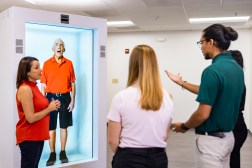U. Central Florida to add flexible hybrid class format this fall

As hundreds of schools plan to return to campus for in-person instruction this fall, the Univeristy of Central Florida will introduce a new hybrid class format designed to offer flexibility for faculty and staff.
The format, dubbed BlendFlex, will include a mixture of face-to-face and online components, the university announced last week.
Though BlendFlex shares a lot of common elements with the “hybrid model” of in-person and online instruction that many universities are anticipating this fall, it’s also specifically designed to provide flexibility for faculty and staff.
“We’ve provided guidelines, such as capacity limits, to ensure safe distancing,” university registrar Brian Boyd told UCF Today. “However, the instructor is really in the best position to make that determination of how they schedule each group of students depending on the structure of the course and the activites they have planned.”
UCF administrators are already planning for some courses to be split into smaller groups to maintain social distancing. Under this arrangement, students would only be permitted to attend one in-person class meeting per week or every other week. Outside of the classroom, students would participate in the rest of their classes either live or via recorded sessions.
The BlendFlex classes will be listed on students’ course catalogs as in-person classes, but will have notes indicating they follow the new format.
Tom Cavanagh, the university’s vice provost for digital learning, said the creation of BlendFlex is expected to “avoid a system of limited, small face-to-face sessions with everything else being only available online.”
“In any given class, at any given point in the term, we know that any number of students or the faculty, may need to be remote for short or long durations,” Cavanagh said. “We need a strategy that will permit this type of flexibility while still allowing students to continue academic progress.”
Professors using the format will also be required to prove they don’t “inadvertently disadvantage” the students who will be tuning in remotely by ensuring that each small group has an equal amount of face-to-face experiences.
“We know that we may not have enough physical rooms to move all courses to larger spaces,” Cavanagh said. “For student-access purposes, we do not want to reduce enrollment to the new reduced-room capacity.”
As for the new format’s longevity, the university, he said, is taking its response to the coronavirus pandemic “one semester at a time.”
“I think that what we do in the future will be in response to the health context and in compliance with safety guidelines,” Cavanagh said. “I will say that we do not intend at this point to continue the BlendFlex delivery strategy as a permanent model.”




